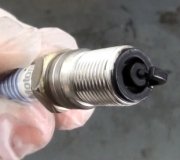HYDRAULIC CONTROL UNIT (HCU) 1. Clean dirt from around master cylinder reservoir cap. Fill master cylinder reservoir with clean DOT 3 brake fluid. Connect drain hose to right rear bleeder screw. Submerge other end of hose in clear container full of clean brake fluid. 2. Pump brake pedal, and then hold firm pressure on brake pedal. Loosen right rear bleeder screw until fluid flows from screw. Have an assistant maintain pressure on brake pedal while tightening bleeder screw. Repeat bleeding procedure until brake fluid flow is clear and free of bubbles. Refill master cylinder reservoir as necessary. 3. Tighten right rear bleeder screw and remove drain hose. Proceed to left rear, right front and left front wheels in sequence. Install New Generation Star (NGS) tester with Cable (007-00531) to Data Link Connector (DLC) located behind left side of instrument panel, and follow NGS tester instructions. Repeat bleeding procedure for all 4 wheels.
VACUUM POWER BOOSTER 1. With a "T" fitting, connect vacuum gauge into vacuum line between engine and power brake booster. With engine at operating temperature, gauge should read 15-19 in. Hg vacuum at idle with transmission in Neutral. If reading is less than specification, stop engine, disconnect vacuum hose at power brake booster and cap open end of hose and open port of vacuum "T". 2. Start engine, and allow it to idle. If reading is still less than 15-19 in. Hg vacuum, engine is producing low vacuum and mechanical problem must be corrected. If vacuum is to specification, check plastic check valve, rubber grommet and vacuum hose connection at power brake booster. 3. With low engine vacuum corrected and/or leaking components replaced, start engine, and allow it to idle. Stop engine, and depress brake pedal for a few seconds. If vacuum drops to zero, booster is leaking and requires replacement. Page 1 of 1 DISC & DRUM -2001 Ford Ranger 4/20/2009
Monday, April 20th, 2009 AT 10:28 AM


